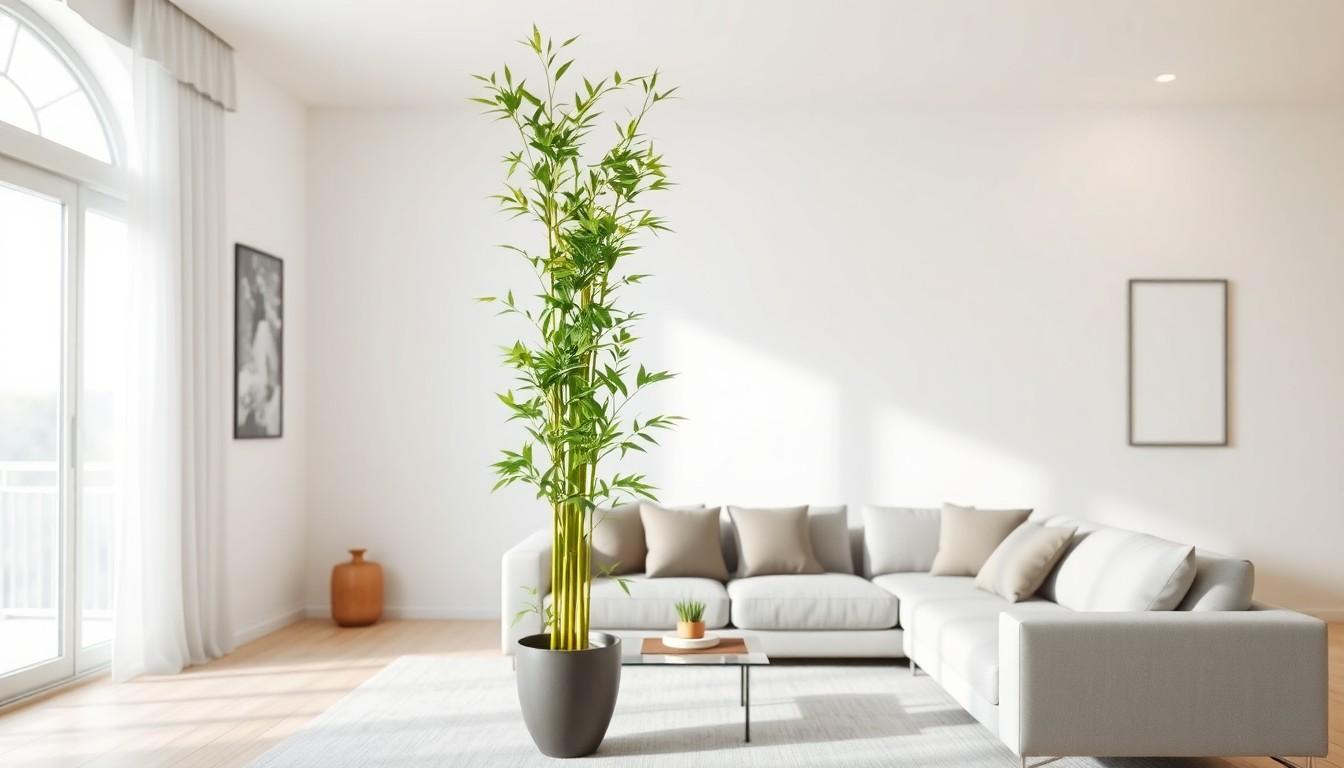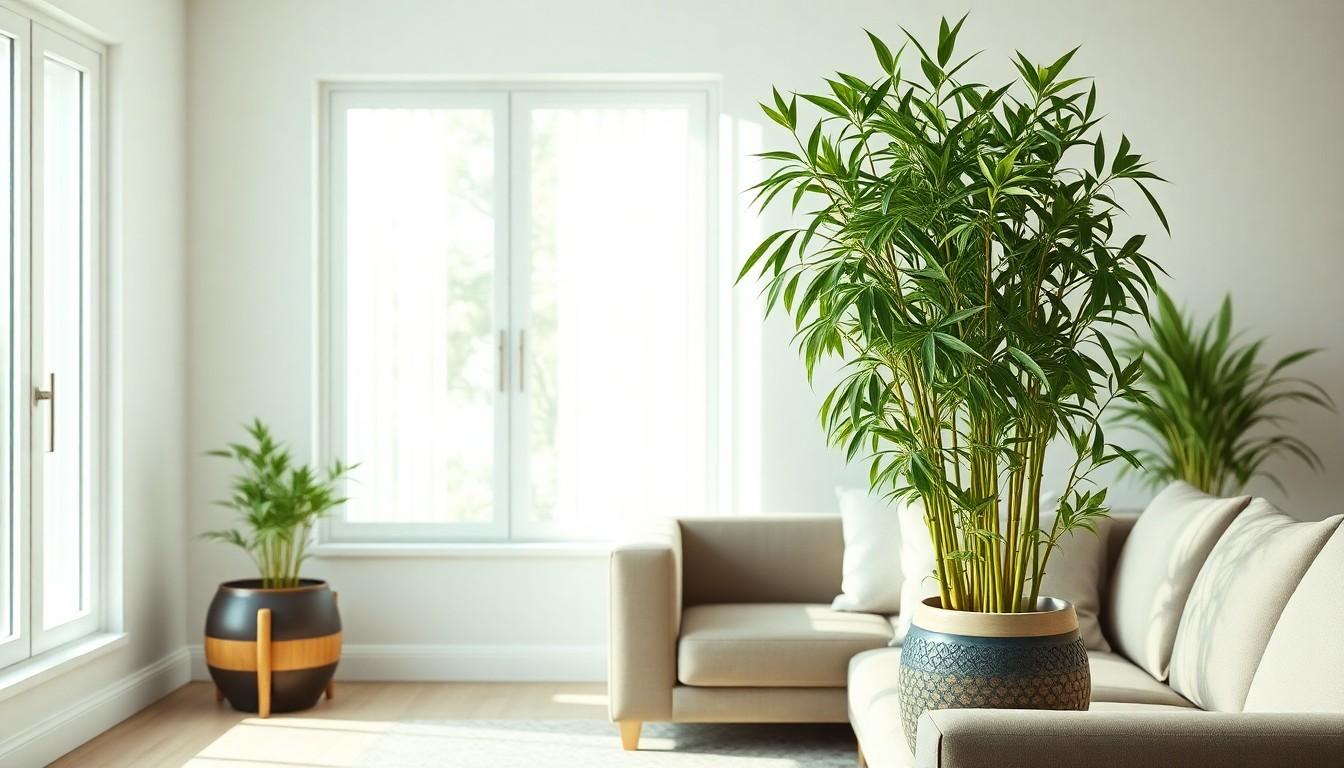Looking to add a touch of tranquility to your home? Indoor bamboo plants might just be the answer. Not only do they bring a slice of nature indoors, but they also double as a stylish décor choice that even your most discerning houseguests will admire. Imagine their surprise when they realize they’re looking at a plant that’s as low-maintenance as it is chic!
Bamboo is like the overachieving sibling of houseplants—it grows quickly, purifies the air, and can thrive in various lighting conditions. Plus, with its unique aesthetic, it’ll have your living space looking like a zen retreat in no time. So why not embrace the green revolution? With indoor bamboo, you can transform your home into a peaceful oasis while effortlessly impressing everyone who walks through your door.
Overview Of Indoor Bamboo Plants
Indoor bamboo plants offer a unique combination of beauty and functionality. Adaptable to various environments, they thrive in diverse lighting conditions, making them suitable for both bright and low-light spaces. Their striking appearance adds an aesthetic touch to any room, enhancing the overall decor.
Low maintenance is a significant advantage. Regular watering keeps indoor bamboo healthy, while occasional pruning encourages lush growth. These plants act as effective air purifiers, helping to remove toxins and improve indoor air quality.
Rapid growth characterizes indoor bamboo varieties. Some types can grow up to 39 inches within a single year. Using bamboo in interior design sets a calm and soothing atmosphere, fostering relaxation. Popular options include Lucky Bamboo and Black Bamboo, each with unique qualities.
Besides their visual appeal, bamboo plants integrate well with various design styles, from minimalist to traditional. They can be displayed in pots, water arrangements, or as part of a larger indoor garden. Many homeowners choose bamboo for its resilience, with some species able to survive in water alone.
Providing the right care ensures long-term health. Keeping indoor bamboo well-drained is crucial, as soggy soil promotes root rot. Moreover, these plants benefit from regular fertilization every two to four weeks during the growing season.
Indoor bamboo plants create a serene environment. Their benefits extend beyond aesthetics, combining elegance with environmental advantages. Embracing bamboo enhances even the most tranquil spaces, giving life to any room.
Benefits Of Indoor Bamboo Plants

Indoor bamboo plants provide numerous advantages that enhance living spaces. Their attributes extend beyond aesthetics, contributing positively to the indoor environment.
Air Purification
Air purification represents a key benefit of indoor bamboo plants. These plants absorb toxins, thereby improving air quality. Research indicates bamboo reduces formaldehyde, xylene, and toluene levels effectively. Improved air quality promotes better health and enhances overall well-being. In addition, bamboo increases oxygen levels, fostering a fresher atmosphere. These qualities make bamboo an excellent choice for homes, particularly for those concerned about indoor pollution.
Aesthetic Appeal
Aesthetic appeal stands out as another advantage of indoor bamboo plants. Their tall, slender stalks create a striking focal point in any room. Varieties such as Lucky Bamboo and Black Bamboo complement various design styles, from modern to traditional. Placing bamboo in decorative pots or water arrangements adds elegance to spaces. Bamboo’s lush green foliage brings a vibrant touch, enhancing visual interest. Incorporating these plants adds a serene, natural element that promotes tranquility within indoor spaces.
Types Of Indoor Bamboo Plants
Indoor bamboo plants come in various types, each offering unique characteristics and benefits. Understanding these varieties helps in making an informed choice for home decor and air quality improvement.
Lucky Bamboo
Lucky Bamboo, known scientifically as Dracaena sanderiana, is a popular choice for indoor spaces. This versatile plant thrives in water or soil, providing flexibility in care. Growing up to three feet tall, it prefers indirect light, making it suitable for apartments and offices. Many place it in decorative pots or as part of a water arrangement for enhanced aesthetic appeal. Often associated with good fortune, Lucky Bamboo is thought to bring prosperity and positivity into a home.
Green Bamboo
Green Bamboo, or Bambusa vulgaris, showcases strikingly vibrant green stalks and can reach impressive heights of over three feet indoors. This variety requires ample sunlight, preferring bright, indirect light for optimal growth. It enjoys well-drained soil, avoiding overwatering to prevent root rot. With its dense foliage, Green Bamboo contributes significantly to air purification, absorbing harmful toxins from the environment. Its rustic appearance enhances both modern and traditional decor, making it a favored option for many households.
Care And Maintenance
Indoor bamboo plants require specific care to thrive and maintain their beauty. Proper attention ensures healthy growth and improves the plant’s air-purifying qualities.
Light Requirements
Indoor bamboo prefers bright, indirect sunlight for optimal growth. Varieties like Lucky Bamboo can adapt to lower light situations, thriving even in shade. Direct sun exposure may scorch the leaves, so placing plants near a window with filtered light works best. Regularly rotating the plant promotes even growth and balances light exposure. For deeper green hues, providing a few hours of bright light daily enhances their vibrancy. Insufficient light may result in leggy growth and pale leaves, affecting the overall aesthetic.
Watering Tips
Watering bamboo appropriately prevents issues such as root rot. Keeping the soil consistently moist without waterlogging promotes healthy development. For potted bamboo, watering every week during active growth months suffices; reduce frequency as growth slows in winter. If using Lucky Bamboo in water, ensure the roots remain submerged and change the water every two weeks. Checking soil moisture levels before watering can prevent over-saturation. Fertilizing during the growing season using a balanced fertilizer every month supports robust growth and vibrant foliage.
Common Pests And Diseases
Indoor bamboo plants, while generally resilient, can face pests and diseases that may affect their health. Aphids often target new growth, leading to stunted development. Treatment includes insecticidal soap or neem oil to eliminate these pests effectively.
Spider mites thrive in dry conditions, causing yellowing leaves and a web-like appearance. Increasing humidity around the plant and applying horticultural oil can help control spider mite populations.
Fungus gnats infest the soil, especially when overwatering occurs. These pesky insects can damage roots and slow plant growth. Allowing the topsoil to dry out before watering will reduce their presence.
Root rot often arises from poor drainage and excessive moisture, leading to wilting and blackened roots. It’s essential to use well-drained soil and pots with drainage holes to prevent this disease.
Bamboo plants may develop leaf spot diseases, showing discoloration or brown spots on leaves. Removing affected leaves and ensuring good air circulation can mitigate this issue.
Scale insects can appear as small bumps on stems and leaves, sucking sap from the plant. A cotton swab dipped in alcohol can remove them effectively.
Powdery mildew shows up as a white, powdery coating on leaves, typically in humid environments. Reducing humidity and increasing airflow around the plant will help prevent this fungus.
Monitoring bamboo plants for signs of pests or diseases ensures timely intervention and promotes healthy growth. Immediate action prevents minor issues from becoming severe, keeping indoor bamboo flourishing.
Conclusion
Indoor bamboo plants offer a unique blend of beauty and practicality. Their ability to thrive in various lighting conditions makes them a versatile choice for any home. With minimal care requirements and impressive air-purifying qualities, these plants contribute to a healthier living environment.
Incorporating bamboo into home decor not only enhances the aesthetic appeal but also creates a calming atmosphere. Whether opting for Lucky Bamboo or Green Bamboo, each variety brings its own charm. By choosing indoor bamboo, individuals can enjoy a stylish and serene space that promotes well-being.

